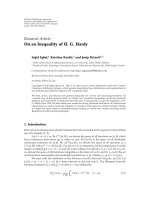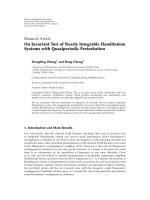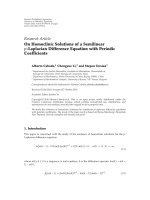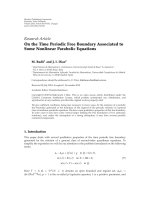Báo cáo hóa học: " Research Article On the Distribution of the q-Euler Polynomials and the q-Genocchi Polynomials of Higher Order" docx
Bạn đang xem bản rút gọn của tài liệu. Xem và tải ngay bản đầy đủ của tài liệu tại đây (488.77 KB, 9 trang )
Hindawi Publishing Corporation
Journal of Inequalities and Applications
Volume 2008, Article ID 723615, 9 pages
doi:10.1155/2008/723615
Research Article
On the Distribution of the q-Euler Polynomials and
the q-Genocchi Polynomials of Higher Order
Leechae Jang
1
and Taekyun Kim
2
1
Department of Mathematics and Computer Science, KonKuk University, Chungju 380-701, South Korea
2
Division of General Education-Mathematics, Kwangwoon University, Seoul 139-701, South Korea
Correspondence should be addressed to Leechae Jang,
Received 19 March 2008; Accepted 23 October 2008
Recommended by L
´
aszl
´
o Losonczi
In 2007 and 2008, Kim constructed the q-extension of Euler and Genocchi polynomials of higher
order and Choi-Anderson-Srivastava have studied the q-extension of Euler and Genocchi numbers
of higher order, which is defined by Kim. The purpose of this paper is to give the distribution of
extended higher-order q-Euler and q-Genocchi polynomials.
Copyright q 2008 L. Jang and T. Kim. This is an open access article distributed under the Creative
Commons Attribution License, which permits unrestricted use, distribution, and reproduction in
any medium, provided the original work is properly cited.
1. Introduction
The Euler numbers E
n
and polynomials E
n
x are defined by the generating function in the
complex number field as
2
e
t
1
∞
n0
E
n
t
n
n!
|t| <π
,
2
e
t
1
e
xt
∞
n0
E
n
x
t
n
n!
|t| <π
,
1.1
cf. 1–4. The Bernoulli numbers B
n
and polynomials B
n
x are defined by the generating
function as
t
e
t
− 1
∞
n0
B
n
t
n
n!
,
t
e
t
− 1
e
xt
∞
n0
B
n
x
t
n
n!
,
1.2
2 Journal of Inequalities and Applications
cf. 5–8. The Genocchi numbers G
n
and polynomials G
n
x are defined by the generating
function as
2t
e
t
1
∞
n0
G
n
t
n
n!
,
2t
e
t
1
e
xt
∞
n0
G
n
x
t
n
n!
,
1.3
cf. 9, 10.ItsatisfiesG
0
0,G
1
1, ,and for n ≥ 1,
G
n
2
n
B
n
1
2
− B
n
. 1.4
Let p be a fixed odd prime number. Throughout this paper, Z
p
, Q
p
, and C
p
will be,
respectively, the ring of p-adic rational integers, the field of p-adic rational numbers and
the p-adic completion of the algebraic closure of Q
p
. The p-adic absolute value in C
p
is
normalized so that |p|
p
1/p. When one talks of q-extension, q is variously considered as
an indeterminate, a complex number q ∈ C or a p-adic number q ∈ C
p
. If q ∈ C, one normally
assumes |q| < 1. If q ∈ C
p
, one normally assumes |1 − q|
p
< 1. We use the notation
x
q
1 − q
x
1 − q
, x
−q
1 − −q
x
1 q
, 1.5
cf. 1–5, 9–23 for all x ∈ Z
p
. For a fixed odd positive integer d with p, d1, set
X X
d
lim
←
n
Z
dp
n
Z
,X
1
Z
p
,
X
∗
0<a<dp
a,p1
a dpZ
p
,
a dp
n
Z
p
x ∈ X | x ≡ a
mod dp
n
,
1.6
where a ∈ Z lies in 0 ≤ a<dp
n
. For any n ∈ N,
μ
q
a dp
n
Z
p
q
a
dp
n
q
1.7
is known to be a distribution on X, cf. 1–5, 9–23.
We say that f is uniformly differentiable function at a point a ∈ Z
p
and denote this
property by f ∈ UDZ
p
, if the difference quotients
F
f
x, y
fx − fy
x − y
1.8
have a limit l f
a as x, y → a, a, cf. 4.
The p-adic q-integral of a function f ∈ UDZ
p
was defined as
I
q
f
Z
p
fxdμ
q
x lim
n →∞
1
p
n
q
p
n
−1
x0
fxq
x
, 1.9
I
−q
f
Z
p
fxdμ
−q
x lim
n →∞
1
p
n
q
p
n
−1
x0
fx−q
x
, 1.10
L. Jang and T. Kim 3
cf. 14.In1.10, when q → 1, we derive
I
−1
f
1
I
−1
f2f0, 1.11
where f
1
xfx 1. If we take fxe
tx
, then we have f
1
xe
tx1
e
tx
e
t
. From 1.11,
we obtain
I
−1
e
tx
Z
p
e
tx
dμ
−1
x
2
e
t
1
∞
n0
E
n
t
n
n!
. 1.12
In view of 1.10, we can consider the q-Euler numbers as follows:
I
−q
e
tx
q
Z
p
e
tx
q
dμ
−q
x
∞
n0
E
n,q
t
n
n!
. 1.13
By 1.12 and 1.13, we obtain the followings.
Lemma 1.1. For n ∈ N,
E
n
G
n1
n 1
. 1.14
Proof. We note that
tI
−1
e
tx
2t
e
t
1
∞
n0
G
n
t
n
n!
∞
n1
G
n
t
n
n!
∞
n0
G
n1
n 1
t
n1
n!
,
tI
−1
e
tx
∞
n0
Z
p
x
n
dμ
−1
x
t
n1
n!
.
1.15
From 1.15, we have
G
n1
n 1
Z
p
x
n
dμ
−1
xE
n
. 1.16
The purpose of this paper is to give the distribution of extended higher order q-Euler and
q-Genocchi polynomials. In 24, Choi-Anderson-Srivastava have studied the q-extension
of the Apostol-Euler polynomials of order n, and the multiple Hurwitz zeta functions see
24. Actually, their results and definitions are not new see 18, 20 and the definition of
the Apostol-Bernoulli numbers in their paper are exactly the same as the definition of the
q-extension of Genocchi numbers. Finally, they conjecture that the following q-distribution
relation holds:
m
q
k−1
m−1
j0
−w
j
E
n
k,q
m
,w
m
x j
m
E
n
k,q,w
x1.17
see 24, Remark 6, page 735. This seems to be nonsense as a conjecture. In this paper we
give the corrected distribution relation related to the conjecture of Choi-Anderson-Srivastava
in 24see Theorem 2.6.
4 Journal of Inequalities and Applications
2. Weighted q-Genocchi number of higher order
In this section, we assume that q ∈ C
p
with |1 − q|
p
< 1orq ∈ C with |q| < 1. For k ∈ N and
w ∈ C
p
with |1 − w|
p
< 1, we define the weighted q-Euler numbers of order k as follows:
E
k
n,q,w
Z
p
···
Z
p
q
k
j1
k−jx
j
w
x
1
···x
k
x
1
··· x
k
n
q
dμ
−q
x
1
···dμ
−q
x
k
. 2.1
We note that q-binomial coefficient is defined by
n
k
q
n
q
n − 1
q
···n − k 1
q
k
q
, 2.2
cf. 20.From2.1, we obtain the following theorem.
Lemma 2.1. For k ∈ N,n∈ N ∪{0} and w ∈ C
p
with |1 − w|
p
< 1, one has
E
k
n,q,w
2
k
q
∞
m0
m k − 1
m
q
−1
m
w
m
q
m
m
n
q
. 2.3
Proof. From 2.1, we have
E
k
n,q,w
Z
p
···
Z
p
q
k
j1
k−jx
j
w
x
1
···x
k
x
1
··· x
k
n
q
dμ
−q
x
1
···dμ
−q
x
k
lim
N →∞
1
p
N
k
−q
p
N
−1
x
1
, ,x
k
0
q
k
j1
k−jx
j
w
x
1
···x
k
x
1
··· x
k
n
q
−q
x
1
···x
k
2
k
q
2
k
1
1 − q
n
lim
N →∞
p
N
−1
x
1
, ,x
k
0
q
k
j1
k−j1x
j
−1
x
1
···x
k
× w
x
1
···x
k
n
l0
n
l
−1
l
q
lx
1
···x
k
2
k
q
2
k
1
1 − q
n
n
l0
n
l
−1
l
2
k
Π
k
j1
1 q
lj
w
2
k
q
1
1 − q
n
n
l0
n
l
−1
l
∞
m0
m k − 1
m
q
−1
m
q
lm
q
m
w
m
2
k
q
∞
m0
m k − 1
m
q
−1
m
q
lm
q
m
w
m
1
1 − q
n
n
l0
n
l
−1
l
q
lm
2
k
q
∞
m0
m k − 1
m
q
−1
m
q
lm
q
m
w
m
m
q
.
2.4
L. Jang and T. Kim 5
Now we consider the following generating functions:
F
k
q,w
t
∞
n0
E
k
n,q,w
t
n
n!
∞
n0
2
k
q
∞
m0
m k − 1
m
q
−1
m
w
m
q
m
m
n
q
2
k
q
∞
m0
m k − 1
m
q
−1
m
w
m
q
m
e
m
q
t
.
2.5
By 2.5, we can define the weighted q-Genocchi numbers of order k:
T
k
q,w
tt
k
F
k
q,w
t
∞
n0
G
k
n,q,w
t
n
n!
. 2.6
From 2.1, 2.2,and2.6,wenotethat
G
k
0,q,w
G
k
1,q,w
··· G
k
k−1,q,w
0,
t
k
∞
n0
E
k
n,q,w
t
n
n!
∞
nk
G
k
n,q,w
t
n
n!
.
2.7
Thus, we obtain
∞
n0
E
k
n,q,w
t
n
n!
∞
nk
G
k
n,q,w
t
n−k
n!
∞
nk
G
k
nk,q,w
t
n
n k!
∞
nk
G
k
nk,q,w
1
m k − 1
m
t
n
n!
.
2.8
From 2.8, we obtain the following recurrsion relation between q-Euler and q-Genocchi
numbers of order k.
Theorem 2.2. For k ∈ N,n∈ N ∪{0} and w ∈ C
p
with |1 − w|
p
< 1, one has
m k
k
k!E
k
n,q,w
G
k
nk,q,w
. 2.9
For k ∈ N, we also define the weighted q-Euler polynomials of order k as follows:
E
k
n,q,w
x
Z
p
···
Z
p
q
k
j1
k−jx
j
w
x
1
···x
k
x x
1
··· x
k
n
q
dμ
−q
x
1
···dμ
−q
x
k
. 2.10
6 Journal of Inequalities and Applications
From 2.9, we obtain the following theorem.
Theorem 2.3. For k ∈ N,n∈ N ∪{0} and w ∈ C
p
with |1 − w|
p
< 1, one has
E
k
n,q,w
x2
k
q
∞
m0
m k − 1
m
q
−1
m
w
m
q
m
x m
n
q
. 2.11
Proof.
E
k
n,q,w
x lim
N →∞
1
p
N
k
−q
p
N
−1
x
1
, ,x
k
0
q
k
j1
k−jx
j
w
x
1
···x
k
x x
1
··· x
k
n
q
−q
x
1
···x
k
2
k
q
2
k
1
1 − q
n
n
l0
n
l
−1
l
q
lx
lim
N →∞
p
N
−1
x
1
, ,x
k
0
q
k
j1
k−jl1x
j
−1
x
1
···x
k
w
x
1
···x
k
2
k
q
2
k
1
1 − q
n
n
l0
n
l
−1
l
q
lx
2
k
Π
k
j1
1 q
lj
w
2
k
q
1
1 − q
n
n
l0
n
l
−1
l
q
lx
∞
m0
m k − 1
m
q
−1
m
q
lm
q
m
w
m
2
k
q
∞
m0
m k − 1
m
q
−1
m
q
lm
q
m
w
m
x m
q
.
2.12
From 2.11, we consider the following generating functions:
F
k
q,w
t, x
∞
n0
E
k
n,q,w
x
t
n
n!
∞
n0
2
k
q
∞
m0
m k − 1
m
q
−1
m
w
m
q
m
x m
n
q
2
k
q
∞
m0
m k − 1
m
q
−1
m
w
m
q
m
e
xm
q
t
.
2.13
By 2.13, we can define the weighted q-Genocchi polynomials of order k as follows:
T
k
q,w
t, xt
k
F
k
q,w
t, x
∞
n0
G
k
n,q,w
x
t
n
n!
. 2.14
From 2.14,wenotethat
G
k
0,q,w
xG
k
1,q,w
··· G
k
k−1,q,w
x0,
t
k
∞
n0
E
k
n,q,w
x
t
n
n!
∞
nk
G
k
n,q,w
x
t
n
n!
.
2.15
L. Jang and T. Kim 7
By comparing the coefficients on both sides, we see that
∞
n0
E
k
n,q,w
x
t
n
n!
∞
nk
G
k
n,q,w
x
t
n−k
n!
∞
nk
G
k
nk,q,w
x
t
n
n k!
∞
nk
G
k
nk,q,w
x
1
m k − 1
m
t
n
n!
.
2.16
From 2.16, we obtain the following recursion relation between weighted q-Euler and
weighted q-Genocchi polynomials of order k.
Theorem 2.4. For k ∈ N,n∈ N ∪{0} and w ∈ C
p
with |1 − w|
p
< 1, one has
m k
k
k!E
k
n,q,w
xG
k
nk,q,w
x. 2.17
Corollary 2.5. For k ∈ N,n∈ N ∪{0} and w ∈ C
p
with |1 − w|
p
< 1, one has
G
k
nk,q,w
xk!
n k
k
2
k
q
1 − q
n
n
l0
n
l
−1
l
q
xl
1
Π
k
j1
1 q
lj
w
k!
n k
k
2
k
q
∞
m0
m k − 1
m
q
−1
m
w
m
q
m
x m
n
q
.
2.18
Let d ∈ N with d ≡ 1mod2. Then we note that
E
k
n,q,w
x
Z
p
···
Z
p
q
k
j1
k−jx
j
w
x
1
···x
k
x x
1
··· x
k
n
q
dμ
−q
x
1
···dμ
−q
x
k
d
m
q
d
k
−q
d−1
i
1
, ,i
k
0
q
k
k
j1
i
j
−
k
j2
j−1i
j
−1
k
j1
i
j
w
i
1
···i
k
×
Z
p
···
Z
p
⎡
⎣
x
k
j1
i
j
d
k
j1
x
j
⎤
⎦
m
q
d
q
d
k
j1
k−jx
j
w
d
x
1
···x
k
× dμ
−q
d
x
1
···dμ
−q
d
x
k
d
m
q
d
k
−q
d−1
i
1
, ,i
k
0
q
k
k
j1
i
j
−
k
j2
j−1i
j
−1
k
j1
i
j
E
k
m,q
d
,w
d
x x
1
··· x
k
d
.
2.19
Therefore, we obtain the f ollowing main results.
8 Journal of Inequalities and Applications
Theorem 2.6 Distribution for higher order q-Euler polynomials. For d ∈ N with d ≡
1mod 2,n∈ N ∪{0} and w ∈ C
p
with |1 − w|
p
< 1, one has
E
k
n,q,w
x
d
m
q
d
k
−q
d−1
i
1
, ,i
k
0
q
k
k
j1
i
j
−
k
j2
j−1i
j
−1
k
j1
i
j
E
k
m,q
d
,w
d
x x
1
··· x
k
d
. 2.20
For k ∈ N,w∈ C with |w| < 1, we easily see that
F
k
q,w
t, x2
k
q
∞
m0
m k − 1
m
q
−1
m
w
m
q
m
e
xm
q
t
∞
m0
E
k
m,q,w
x
t
m
m!
. 2.21
Thus we have
E
k
n,q,w
x
d
n
dt
n
F
k
q,w
t, x2
k
q
∞
m0
−1
m
q
m
w
m
x m
n
q
m k − 1
m
q
2.22
Definition 2.7. For s ∈ C,k∈ N and w ∈ C with |w| < 1, one has
ζ
k
q,w,E
s, x2
k
q
∞
m0
−1
m
w
m
q
m
m k − 1
m
q
m x
s
q
. 2.23
Note that ζ
k
q,w,E
s, x is analytic function in the whole complex s-plane. From 2.23,
we derive the following.
Theorem 2.8. For n ∈ N ∪{0},k ∈ N and w ∈ C
p
with |1 − w|
p
< 1, one has
ζ
k
q,w,E
−n, xE
k
n,q,w
x. 2.24
Acknowledgments
The present research has been conducted by the research Grant of Kwangwoon University
in 2008. The authors express their gratitude to referees for their valuable suggestions and
comments.
References
1 L C. Jang, S D. Kim, D W. Park, and Y S. Ro, “A note on Euler number and polynomials,” Journal
of Inequalities and Applications, vol. 2006, Article ID 34602, 5 pages, 2006.
2 T. Kim, “On Euler-Barnes multiple zeta functions,” Russian Journal of Mathematical Physics, vol. 10, no.
3, pp. 261–267, 2003.
3 T. Kim, “A note on p-adic q-integral on
Z
p
associated with q-Euler numbers,” Advanced Studies in
Contemporary Mathematics, vol. 15, no. 2, pp. 133–137, 2007.
4 T. Kim, “On p-adic interpolating function for q-Euler numbers and its derivatives,” Journal of
Mathematical Analysis and Applications, vol. 339, no. 1, pp. 598–608, 2008.
5 L. Carlitz, “q-Bernoulli numbers and polynomials,” Duke Mathematical Journal, vol. 15, no. 4, pp. 987–
1000, 1948.
6 Y. Simsek, V. Kurt, and D. Kim, “New approach to the complete sum of products of the twisted
h, q-Bernoulli numbers and polynomials,” Journal of Nonlinear Mathematical Physics, vol. 14, no. 1,
pp. 44–56, 2007.
L. Jang and T. Kim 9
7 H. Ozden, I. N. Cangul, and Y. Simsek, “Remarks on sum of products of h, q-twisted Euler
polynomials and numbers,” Journal of Inequalities and Applications, vol. 2008, Article ID 816129, 8
pages, 2008.
8 H. Ozden, I. N. Cangul, and Y. Simsek, “Multivariate interpolation functions of higher-order q-Euler
numbers and their applications,” Abstract and Applied Analysis, vol. 2008, Article ID 390857, 16 pages,
2008.
9 T. Kim, L C. Jang, and H. K. Pak, “A note on q-Euler and Genocchi numbers,” Proceedings of the Japan
Academy. Series A, vol. 77, no. 8, pp. 139–141, 2001.
10 T. Kim, “On the multiple q-Genocchi and Euler numbers,” Russian Journal of Mathematical Physics, vol.
15, no. 4, pp. 481–486, 2008.
11 M. Cenkci and M. Can, “Some results on q-analogue of the Lerch zeta function,” Advanced Studies in
Contemporary Mathematics, vol. 12, no. 2, pp. 213–223, 2006.
12 M. Cenkci, Y. Simsek, and V. Kurt, “Further remarks on multiple p-adic q-l-function of two variables,”
Advanced Studies in Contemporary Mathematics, vol. 14, no. 1, pp. 49–68, 2007.
13 T. Kim, “q-Volkenborn integration,” Russian Journal of Mathematical Physics, vol. 9, no. 3, pp. 288–299,
2002.
14 T. Kim, “Analytic continuation of multiple q-zeta functions and their values at negative integers,”
Russian Journal of Mathematical Physics, vol. 11, no. 1, pp. 71–76, 2004.
15 T. Kim, “Power series and asymptotic series associated with the q-analog of the two-variable p-adic
L-function,” Russian Journal of Mathematical Physics, vol. 12, no. 2, pp. 186–196, 2005.
16 T. Kim, “Multiple p-adic L-function,” Russian Journal of Mathematical Physics, vol. 13, no. 2, pp. 151–
157, 2006.
17 T. Kim, “On the analogs of Euler numbers and polynomials associated with p-adic q-integral on Z
p
at
q −1,” Journal of Mathematical Analysis and Applications, vol. 331, no. 2, pp. 779–792, 2007.
18 T. Kim, “q-Euler numbers and polynomials associated with p-adic q-integrals,” Journal of Nonlinear
Mathematical Physics, vol. 14, no. 1, pp. 15–27, 2007.
19 T. Kim, “On p-adic interpolating function for q-Euler numbers and its derivatives,” Journal of
Mathematical Analysis and Applications, vol. 339, no. 1, pp. 598–608, 2008.
20 T. Kim, “q-Bernoulli numbers and polynomials associated with Gaussian binomial coefficients,”
Russian Journal of Mathematical Physics, vol. 15, no. 1, pp. 51–57, 2008.
21 T. Kim, M S. Kim, L. Jang, and S H. Rim, “New q-Euler numbers and polynomials associated with
p-adic q-integrals,” Advanced Studies in Contemporary Mathematics, vol. 15, no. 2, pp. 243–252, 2007.
22 H. Ozden and Y. Simsek, “A new extension of q-Euler numbers and polynomials related to their
interpolation functions,” Applied Mathematics Letters, vol. 21, no. 9, pp. 934–939, 2008.
23 H. Ozden, Y. Simsek, S H. Rim, and I. N. Cangul, “A note on p-adic q-Euler measure,” Advanced
Studies in Contemporary Mathematics, vol. 14, no. 2, pp. 233–239, 2007.
24 J. Choi, P. J. Anderson, and H. M. Srivastava, “Some q-extensions of the Apostol-Bernoulli and the
Apostol-Euler polynomials of order n, and the multiple Hurwitz zeta function,” Applied Mathematics
and Computation, vol. 199, no. 2, pp. 723–737, 2008.









